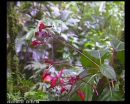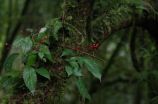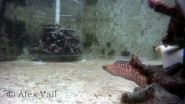(Press-News.org) VIDEO:
When a bird forages on nectar, the flower twists as the spur complies with the shape of the
bird's bill. In consequence, pollen is placed in an unusual location on...
Click here for more information.
When researchers studying several bird-pollinated species of Impatiens flowers in the mountains of western Cameroon noticed one with an odd, upwardly curving nectar spur, they couldn't imagine how any sunbird could ever sip from it. After recording visitors to the flower continuously for a period of days, they had their answer, which they report in the Cell Press journal Current Biology on September 8.
When sunbirds insert their beaks into those funny-shaped spurs, the flowers do a little twist. That apparently small modification significantly affects how pollen is placed on the birds' bodies, increasing the likelihood that the pollen will successfully land on the stigma of another member of the same flower species to produce the next generation of Impatiens frithii.
The observation offers the first evidence of a pollination system in which plants have overcome floral architecture constraints on pollen placement by twisting their nectar spurs, according to the researchers. It is also an example of how evolution sometimes comes up with elegant and unexpected solutions, they say.
"When we saw the recordings from the cameras, we were really excited," says Michael Bartoš of the Institute of Botany at the Academy of Sciences of the Czech Republic, noting that the twisting action happens so quickly it is almost imperceptible to a casual observer. "We did not expect that the fit between flower spur and sunbird bill could be solved in such a simple way. Our enthusiasm was even greater when we realized the adaptive consequence for pollen placement."
I. frithii is an epiphyte. The plant grows on the surface of smaller trees or lower tree branches, with its red flowers protruding out of the foliage, explains Bartoš and his colleague Štěpán Janeček. While the architecture of other bird-pollinated flowers means that pollen can be placed only on birds' bellies or backs, more than 160 hours of video footage showed that the unique shape of I. frithii blossoms allows for placement of pollen on the underside of a visiting sunbird's head or bill.
That seemingly small difference in floral architecture and pollen placement must serve to reduce competition among I. frithii and its close relatives. It also presents a barrier between species. The discovery could have far-reaching implications for the plants' evolutionary past and future.
"Our observations demonstrate that a minute change in floral morphology can effectively overcome constraints resulting from the basal floral architecture early in the group's evolution," Bartoš and Janeček write. "We assume that such adaptations can not only help the plants avoid interspecific competition, but, as the adaptations create strong reproductive barriers, they may also contribute to plant speciation."
INFORMATION:
Current Biology, Bartos et al.: "Pollinator-induced twisting of flowers sidesteps floral architecture constraints."
A bird-pollinated flower with a rather ingenious twist
2014-09-08
ELSE PRESS RELEASES FROM THIS DATE:
Coral trout pick their collaborators carefully
2014-09-08
VIDEO:
Coral trout are choosey about moray collaborators.
Click here for more information.
Coral trout not only work with moray eels to improve their chances of a meal, but they can also be choosy when it comes to picking the best moray partner. The findings reported in the Cell Press journal Current Biology on September 8 show that such sophisticated collaborative abilities are not limited to apes and humans.
The fish's behavior is remarkable in other ways too, the researchers ...
Fish as good as chimpanzees at choosing the best partner for a task
2014-09-08
Coral trout are fast when chasing prey above the reefs of their habitat, but can't pursue their quarry if it buries itself into a hard-to-reach reef crevice.
When this happens, the trout will team up with a snake-like moray eel to flush out the unfortunate fish in a remarkable piece of interspecies collaboration: either the eel takes the prey in the reef, or scares it back into the open so the trout can pounce.
Coral trout - along with close relative the roving coral grouper - will use gestures and signals to flag the location of prey to an eel, including head shakes ...
Hog workers carry drug-resistant bacteria even after they leave the farm
2014-09-08
A new study suggests that nearly half of workers who care for animals in large industrial hog farming operations may be carrying home livestock-associated bacteria in their noses, and that this potentially harmful bacteria remains with them up to four days after exposure.
Researchers had believed that livestock-associated bacteria would clear from the noses of hog workers quickly – within 24 hours. But this small study of hog workers in North Carolina, reported online Sept. 8 in the journal Occupational and Environmental Medicine, suggests it can stick around longer. ...
Popular cancer drug target implicated in cardiovascular defects
2014-09-08
September 8, 2014 CHAPEL HILL – UNC School of Medicine researchers have discovered an unlikely relationship between CXCR7 – a protein implicated in tumor growth and metastasis – and adrenomedullin – a hormone involved in cardiovascular health. Deleting CXCR7 allows adrenomedullin to run rampant, triggering the development of an enlarged heart and the overgrowth of the lymphatic vessels that traffic immune cells and fluids throughout the body.
The study, published September 8 in the journal Developmental Cell, reveals that CXCR7 binds to the ligand adrenomedullin. The ...
UNC researchers find new genetic target for a different kind of cancer drug
2014-09-08
CHAPEL HILL, NC – Researchers from the UNC School of Medicine have discovered that the protein RBM4, a molecule crucial to the process of gene splicing, is drastically decreased in multiple forms of human cancer, including lung and breast cancers. The finding, published today in the journal Cancer Cell, offers a new route toward therapies that can thwart the altered genetic pathways that allow cancer cells to proliferate and spread.
"Historically, scientists haven't targeted the proteins in cancer cells that are involved in gene splicing," said Zefeng Wang, PhD, associate ...
Scientists apply biomedical technique to reveal changes in body of the ocean
2014-09-08
For decades, doctors have developed methods to diagnose how different types of cells and systems in the body are functioning. Now scientists have adapted an emerging biomedical technique to study the vast body of the ocean.
In a paper published this week in the journal Science, scientists demonstrate that they can identify and measure proteins in the ocean, revealing how single-celled marine organisms and ocean ecosystems operate.
The National Science Foundation (NSF) and the Gordon and Betty Moore Foundation funded the research.
"Proteins are the molecules that catalyze ...
Faces are more likely to seem alive when we want to feel connected
2014-09-08
Feeling socially disconnected may lead us to lower our threshold for determining that another being is animate or alive, according to new research published in Psychological Science, a journal of the Association for Psychological Science.
"This increased sensitivity to animacy suggests that people are casting a wide net when looking for people they can possibly relate to — which may ultimately help them maximize opportunities to renew social connections," explains psychological scientist and lead researcher Katherine Powers of Dartmouth College.
These findings enhance ...
Bone cancer surgical team sees success in new application of surgical aid
2014-09-08
(9/8/14, Lebanon, NH) —An ortho-oncology team at Dartmouth-Hitchcock Norris Cotton Cancer Center successfully adapted a shoulder surgical aid (the Spider Limb Positioner) to conduct a left hip disarticulation on a melanoma patient as described in a case report published online in Medical Devices.
The Spider Limb Positioner is a pneumatic arm with three fully articulating joints that can be infinitely adjusted in relation to the operating table where it is mounted. The positioner mobilizes patients' limbs so surgeons don't have to, thereby freeing up both their hands ...
Study shows nationwide declines in central line infections and ventilator pneumonias
2014-09-08
Hospitals across the country have seen sharp declines in rates of central line-associated blood stream infections (CLABSIs) and ventilator-associated pneumonias (VAPs) among critically ill neonates and children, according to a new study in the journal Pediatrics.
The study, "Health care-associated infections among critically ill children in the U.S.," analyzed incidences rates of CLABSIs, VAPs and catheter-associated urinary tract infections (CAUTIs) for 173 neonatal intensive care units (NICUs) and 64 pediatric intensive care units (PICUs) from 2007-2012.
"Central ...
Pastors get scant seminary training on how to help mentally ill, Baylor study finds
2014-09-08
People struggling with mental illness often turn to pastors for help, but seminaries do very little to train ministers how to recognize serious psychological distress and when to refer someone to a doctor or psychologist, according to a Baylor University study.
As a result, "many people in congregations continue to suffer under well-meaning pastors who primarily tell them to pray harder or confess sin in relation to mental health problems," said lead researcher Matthew S. Stanford, Ph.D., professor of psychology and neuroscience in Baylor's College of Arts & Sciences.
The ...




